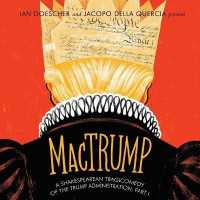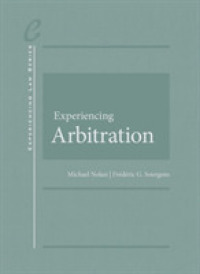- ホーム
- > 洋書
- > 英文書
- > Architecture
Full Description
Writing the Materialities of the Past offers a close analysis of how the materiality of the built environment has been repressed in historical thinking since the 1950s. Author Sam Griffiths argues that the social theory of cities in this period was characterised by the dominance of socio-economic and linguistic-cultural models, which served to impede our understanding of time-space relationality towards historical events and their narration.
The book engages with studies of historical writing to discuss materiality in the built environment as a form of literary practice to express marginalised dimensions of social experience in a range of historical contexts. It then moves on to reflect on England's nineteenth-century industrialization from an architectural topographical perspective, challenging theories of space and architecture to examine the complex role of industrial cities in mediating social changes in the practice of everyday life.
By demonstrating how the authenticity of historical accounts rests on materially emplaced narratives, Griffiths makes the case for the emancipatory possibilities of historical writing. He calls for a re-evaluation of historical epistemology as a primarily socio-scientific or literary enquiry and instead proposes a specifically architectural time-space figuration of historical events to rethink and refresh the relationship of the urban past to its present and future. Written for postgraduate students, researchers and academics in architectural theory and urban studies, Griffiths draws on the space syntax tradition of research to explore how contingencies of movement and encounter construct the historical imagination.
Contents
Introduction: the architectural topography of historical imagination Part I: Contingency in the historiographies of the English reformation, French revolution and era of the industrial revolution in England 1. Contingency and artifice 2. Encounter and utterance 3. Milieu and movement 4. Figure and event Part II: Writing history as a city 5. Proximity and distance 6. The revolutionary encounter field: Paris c.1789-94 and other stories 7. Recollection and re-enactment 8. Morphologies of feeling Appendix A: A notation for the architectural topographic sequencing of texts Appendix B: Synopsis of Cinderella Appendix C: Additional architectural topographic sequences from Cinderella Appendix D: Search terms and categories used in toponemic analysis references index







